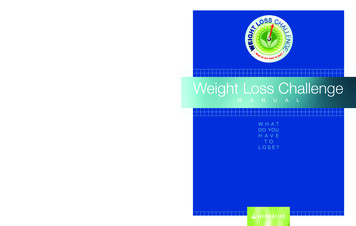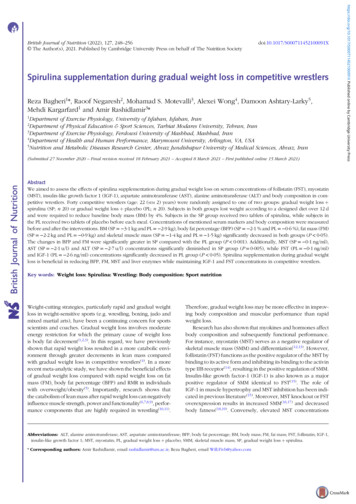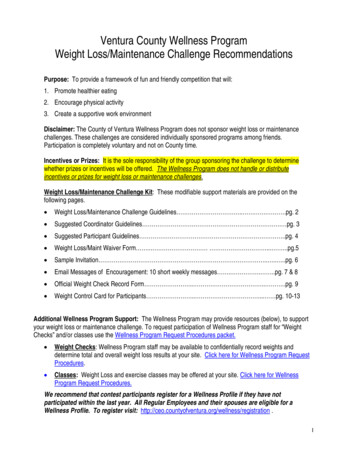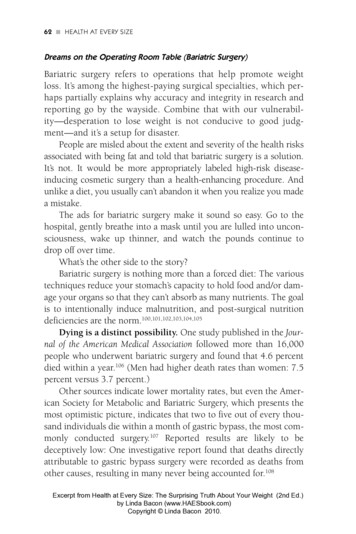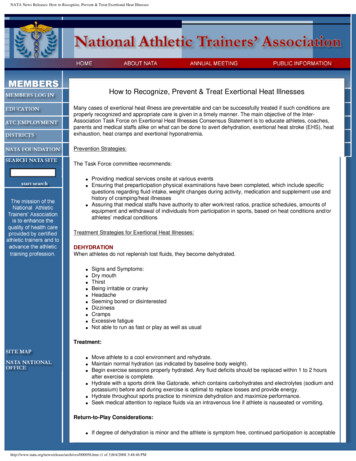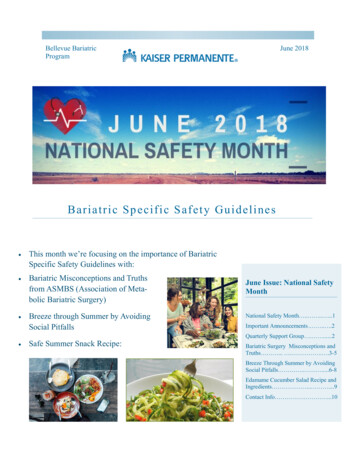
Transcription
Early Weight Loss Nomograms forExclusively Breastfed NewbornsValerie J. Flaherman, MD, MPHa,b, Eric W. Schaefer, MSc, Michael W. Kuzniewicz, MD, MPHa,d, Sherian X. Li, MSd,Eileen M. Walsh, MPH, RNd, Ian M. Paul, MD, MSc,eabstractBACKGROUND: Themajority of newborns are exclusively breastfed during the birth hospitalization,and weight loss is nearly universal for these neonates. The amount of weight lost variessubstantially among newborns with higher amounts of weight loss increasing risk formorbidity. No hour-by-hour newborn weight loss nomogram exists to assist in earlyidentification of those on a trajectory for adverse outcomes.For 161 471 term, singleton neonates born at 36 weeks’ gestation at NorthernCalifornia Kaiser Permanente hospitals in 2009–2013, data were extracted from the birthhospitalization regarding delivery mode, race/ethnicity, feeding type, and weights fromelectronic records. Quantile regression was used to create nomograms stratified by deliverymode that estimated percentiles of weight loss as a function of time among exclusively breastfedneonates. Weights measured subsequent to any nonbreastmilk feeding were excluded.METHODS:RESULTS: Among this sample, 108 907 newborns had weights recorded while exclusivelybreastfeeding with 83 433 delivered vaginally and 25 474 delivered by cesarean. Differentialweight loss by delivery mode was evident 6 hours after delivery and persisted over time.Almost 5% of vaginally delivered newborns and .10% of those delivered by cesarean had lost 10% of their birth weight 48 hours after delivery. By 72 hours, .25% of newborns deliveredby cesarean had lost 10% of their birth weight.CONCLUSIONS: These newborn weight loss nomograms demonstrate percentiles for weight loss bydelivery mode for those who are exclusively breastfed. The nomograms can be used for earlyidentification of neonates on a trajectory for greater weight loss and related morbidities.WHAT’S KNOWN ON THIS SUBJECT: Exclusivelybreastfed newborns lose weight daily in the firstfew days after birth. The amount of weight lostvaries substantially between newborns, withhigher amounts of weight loss increasing risk formorbidity.WHAT THIS STUDY ADDS: This study presentsnomograms demonstrating percentiles forweight loss by delivery mode for those who areexclusively breastfed. The nomograms havepotential to be used for early identification ofneonates on a trajectory for greater weight lossand related morbidities.Departments of aPediatrics, and bEpidemiology and Biostatistics, School of Medicine, University of California, SanFrancisco, California; Departments of cPublic Health Sciences, and ePediatrics, Penn State College of Medicine,Hershey, Pennsylvania; and dDivision of Research, Kaiser Permanente, Oakland, CaliforniaDr Flaherman conceptualized and designed this study, oversaw all aspects of the data collectionand analysis, and drafted the initial manuscript; Mr Schaefer contributed to the study design,analyzed the data, and critically revised the manuscript for important scientific content; DrKuzniewicz contributed to the study design, participated in data analysis, and critically revised themanuscript for important scientific content; Ms Li contributed to the study design, coordinated datacollection, carried out preliminary analyses, and critically revised the manuscript for importantscientific content; Ms Walsh participated in study design and data analysis and critically revised themanuscript for important scientific content; Dr Paul conceptualized and designed this study,obtained funding, and critically revised the manuscript for important scientific content; and allauthors approved this manuscript as 2014-1532DOI: 10.1542/peds.2014-1532Accepted for publication Oct 3, 2014ARTICLEDownloaded from pediatrics.aappublications.org by Ian Paul on January 1, 2015PEDIATRICS Volume 135, number 1, January 2015
The World Health Organization, theCenters for Disease Control andPrevention, and the AmericanAcademy of Pediatrics all recommend breastfeeding exclusivelyduring the birth hospitalizationwithout any supplementary formulaor water,1–3 and in the UnitedStates, 60% of newborns arebreastfed exclusively for at least thefirst 2 days.4 Among such exclusively breastfed neonates, enteralintake is low during the time ofcolostrum production,5–7 and initialpostnatal weight loss is nearly universal.8–10 Although the brief periodof low enteral intake and weightloss is well tolerated by most newborns, some develop complicationsof weight loss such as hyperbilirubinemia and dehydration, the 2most common causes of neonatalmorbidity.11–17To monitor for potential morbidity,weight and jaundice are evaluateddaily during the birth hospitalization, with weight generally decreasing and bilirubin levels generallyincreasing. A nomogram publishedin 1999 depicting bilirubin levels byhour of age18 is widely used toevaluate trajectories of neonatalhyperbilirubinemia19 and has beenincorporated into the AmericanAcademy of Pediatrics guideline onhyperbilirubinemia management.20However, similarly detailed hourspecific values and trajectories fornewborn weight loss have not beenpreviously reported. Therefore, wesought to develop a detailedgraphical depiction of earlytrajectories of weight loss forexclusively breastfed newborns.Such a weight loss nomogramwould be of great clinical utilitybecause newborn weight ismeasured daily at varying hoursof age, and these measurementsbecome the basis for multipleclinical decisions including timingof discharge, need for lactationsupport or supplementation, andtiming and type of newborn followup.21,22METHODSParticipants and OutcomesThe analysis included 161 471newborns who were born at 36 weeks’ gestation at 1 of 14 KaiserPermanente Northern Californiahospitals between January 1, 2009, andDecember 31, 2013, who survived todischarge home and who did notreceive Level II or Level III care. Forthis reason, newborns with infectiousdisease or congenital abnormalitiesrequiring Level II or Level III care werenot included in this cohort. Forincluded newborns, data wereextracted on all weights obtainedduring the birth hospitalization as wellas on gestational age, method ofdelivery, length of stay, hospital of birth,maternal race/ethnicity, and timing(hour of age) and type (breast milk orformula) of all inpatient feedings. Fromthis cohort, newborns were excluded ifthey had missing data on type ofdelivery, weight or feeding, birth weight,2000 g or .5000 g, multiple birth,discrepantly reported birth weightsbetween data sources, or no weightdocumented after 6 hours of age andbefore initiation of formula feeding.Weight change was defined as thedifference between birth weight andeach weight recorded subsequently,calculated as a percentage of birthweight as is typically done daily inclinical practice. Excess weight loss wasdefined as the loss of 10% of birthweight.9,23 Newborns with implausibleweight loss or weight gain values(.10% loss in the first 24 hours,.15% loss at any time thereafter, gain.5%) were excluded. Because lengthof stay varies by method of deliveryand because neonates are usuallyweighed once daily during the birthhospitalization but not usually within6 hours of birth, weight loss percentileswere determined from 6 to 72 hoursfor vaginal births and from 6 to96 hours for cesarean births, reflectingthe difference in length of stay bydelivery mode and the correspondingvariation in availability of weightmeasurements between vaginallydelivered newborns and thosedelivered by cesarean.24FIGURE 1Derivation of the final analytic cohort.Downloaded from pediatrics.aappublications.org by Ian Paul on January 1, 2015PEDIATRICS Volume 135, number 1, January 2015e17
TABLE 1 Demographic and Clinical Characteristics of Included Newborns, by Type of DeliveryBirth wt (g)Mean (SD)MedianInterquartile rangeRangeGestational age (wk), n (%)3637383940414243Gestational age (wk)Mean (SD)MedianInterquartile rangeRangeMaternal race/ethnicity, n (%)HispanicAmerican Indian/EskimoAsianBlack, non-HispanicWhite, non-HispanicUnknownNewborn hospital length of stay (d)aMean (SD)MedianInterquartile rangeaVaginal (n 83 433)Cesarean (n 25 474)3416.9 (426.2)3402(3120–3700)(2000–5000)3487.7 )(7.0)(18.1)(32.8)(28.8)(11.2)(0.4)(0.0)39.2 0(24.5)(0.4)(23.7)(6.2)(42.8)(2.7)1.7 .9)(0.7)(,0.1)39.1 3.1)(0.4)(23.9)(7.5)(42.3)(2.8)2.8 (0.9)2.6(2.1–3.2)There were missing length of stay data for 210 vaginally delivered and 87 Cesarean-delivered newborns.A newborn was included in the finalanalysis if any weight measurementwas obtained during the birthhospitalization after 6 hours of ageand before exclusive breastfeedingwas discontinued. Between 6 and72 hours for vaginal births and 6 and96 hours for cesarean births, allweights obtained during the birthhospitalization were used if at thetime the weight was obtained thenewborn remained exclusivelybreastfed as defined by the WorldHealth Organization (nothing otherthan breast milk, vitamins, minerals,and oral medications).25,26 Newbornswere censored at the time of the firstsupplementary feeding. No weightsobtained subsequent to censoring orafter discharge from the birthhospitalization were used in thisanalysis. This study was approved bythe University of California SanFrancisco Committee on HumanResearch and by the Institutionale18Review Boards of Penn State MedicalCollege and Kaiser PermanenteNorthern California.AnalysesQuantile regression methodsappropriate for data with repeatedmeasures were used to estimate 50th(median), 75th, 90th, and 95thpercentiles of weight loss asa function of time after birth. Thepenalized fixed-effects model in the Rpackage “Regression Quantiles forPanel Data” was used to estimate thepercentile curves.27 The model is anextension of ordinary quantileregression28 to longitudinal settingsin which newborns may be weighedat multiple time points. The modelaccounts for multiple (or repeated)weights from a newborn by includinga separate intercept parameter foreach newborn, with regularizationused to estimate these intercepts byshrinking them toward a commonvalue. The amount of regularization iscontrolled by a tuning parameter,which was set equal to 5 so that mostintercepts were shrunk to zero,a prudent choice for sparselongitudinal data that includes manynewborns contributing only a singledata point (62% of newborns in thesample had only 1 weight included inthe analysis). A B-spline basis with 4degrees of freedom was used togenerate nonlinear percentile curves.29Nonparametric bootstrapping with 500resamples and the percentile methodwere used to obtain confidenceintervals for each percentile curve.30 Toexamine the reliability and robustnessof the final estimated percentile curves,we generated separate curves for thecohort born 2009–2010 and the cohortborn 2011–2013.We examined whether ournomograms were affected by theinclusion of late preterm, postterm,and small or large-for-gestational-ageinfants by removing all newbornsborn at ,37 weeks and 42 weeksfrom the cohort, and those with birthweights below the 10th percentileand above the 90th percentile forgestational age. The quantileregression model was refit on thebasis of these exclusions, and weexamined how the estimatedpercentile curves changed.To determine whether censoringnewborns after formula use may havecaused bias to the estimatedpercentile curves, we undertookTABLE 2 Number of Weights Used in the Final Analysis, n (%)Weights Recorded After Birth Weight1234Vaginal (n 83 433), n (%)59 95321 4401825215(71.9)(25.7)(2.2)(0.3)Downloaded from pediatrics.aappublications.org by Ian Paul on January 1, 2015Cesarean (n 25 474), n (%)640212 42355551094(25.1)(48.8)(21.8)(4.3)FLAHERMAN et al
TABLE 3 Number of Weights Included for Each 12-Hour IntervalTime, hVaginal (n 109 190), n 485–9623 914 (21.9)45 394 (41.6)26 185 (24)10 833 (9.9)2168 (2.0)696 (0.6)——Cesarean (n 52 443), n (%)722114 377986611 )(1.5)(0.8)—, not included.a sensitivity analysis. If previouslyexclusively breastfed newbornsbegan using formula supplementationprimarily because of high levels ofweight loss, then the estimatedcurves may have underestimated theactual weight loss in the population.To examine this possibility, thesensitivity analysis recreated thenomograms after using matching toimpute subsequent weights fornewborns who had 1 included weightrecorded during the birthhospitalization and then werecensored. First, each newborncensored due to formula use wasmatched to 1 uncensored newbornusing a greedy matching algorithm.31Matches were conditional on 3variables: time of most recent weightmeasurement in which the censorednewborn had been exclusivelybreastfed (62 hours), percent weightloss at that time (63 percentagepoints), and gestational age(63 weeks). The weight loss datafrom the uncensored newborn thatoccurred after formula use began forthe censored newborn was thenimputed as the actual weight lossdata for the censored newborn. Last,the quantile regression model wasrefit using the original data plus theimputed data for censored newbornsto examine how the estimatedpercentile curves changed. The mainassumption of this sensitivity analysisis that the weight loss history of thematched uncensored newbornreasonably approximates the weightloss history that would have beenobserved for the censored newbornhad formula never been introduced.RESULTSFrom 161 471 newborns in the cohort,108 907 were included in the finalanalysis, of whom 83 433 (76.6%)were delivered vaginally and 25 474(23.4%) were delivered by cesarean.Among 52 564 excluded newborns, 33715 (64%) were excluded because noweight was obtained in the eligibleperiod and before formula feeding, 18368 (35%) were excluded due to eithermultiple birth or missing or discrepantbirth data, and 481 (0.9%) wereexcluded because weight loss exceeded10% in 24 hours or 15% at any time orbecause weight gain exceeded 5%(Fig 1). Data were available on race/ethnicity for 97.3% of mothers, and thecohort was racially diverse; 24% ofmothers were Hispanic, 24% wereAsian, 7% were black non-Hispanic,and 43% were white non-Hispanic.Other demographic and clinicalcharacteristics are summarized inTable 1.For neonates delivered vaginally, 109190 weights subsequent to birthweight were recorded (1.3 pernewborn), and for those delivered bycesarean, 52 443 were recorded(2.1 per newborn). A majoritydelivered vaginally (71.9%) had only1 weight recorded during the followup, whereas a majority delivered viacesarean (74.9%) had 2 weightsrecorded (Table 2). The differencereflects the longer length of stay forcesarean newborns. See Table 3 fordetails on the distribution of age inhours for included weights.Differences in weight loss by deliverytype appeared early and were clearlyevident within 24 hours of birth.Figure 2A presents percentile curvesfor vaginally delivered newborns.Median percent weight loss for theseneonates was 4.2%, 7.1%, and 6.4%at 24, 48, and 72 hours of age,respectively. By 48 hours, almost 5%of vaginally delivered newborns hadlost at least 10% of their birth weight,and by shortly after 48 hours, thepercentile curves for median weightloss had begun to rise. Figure 2Bpresents percentile curves fornewborns delivered by cesarean.Median percent weight loss amongthese neonates was 4.9%, 8.0%, 8.6%and 5.8% at 24, 48, 72, and 96 hoursafter delivery. By 48 hours of age,almost 10% of newborns delivered bycesarean had lost at least 10% oftheir birth weight, and by 72 hours ofage, the percentile curves for medianweight loss had begun to rise, but.25% were at least 10% below theirbirth weight.Percentile curves with 95%confidence intervals overlaid areshown in Supplementary Figure 3 Aand B. Percentile curves estimatedfrom the cohort of 34 809 newbornsborn 2009–2010 were similar to thepercentile curves estimated from thecohort of 74 098 newborns born 2011–2013 (Supplemental Figure 4 A and B).Percentile curves generated afterremoving late preterm, postterm, andsmall- and large-for-gestational-agenewborns were not visuallydistinguishable from the main results(Supplemental Fig 5 A and B).In our main analysis depicted in Fig 2A and B, 8457 newborns deliveredvaginally (10.1%) and 8414newborns delivered by cesarean(33.0%) had at least 1 weightincluded in the analysis and at least 1weight censored from the analysisbecause it was obtained subsequentto a supplementary feeding. Insensitivity analysis, weights wereimputed for censored newbornsbased on matching to uncensorednewborns. More than 98% ofcensored newborns had exactDownloaded from pediatrics.aappublications.org by Ian Paul on January 1, 2015PEDIATRICS Volume 135, number 1, January 2015e19
matches for time and gestational age,and .90% had a match of percentweight loss within 0.20 percentagepoints (Table 4). Percentile curvesestimated from the original data plusthe imputed data for censoredweights were similar to the curves ofthe original data for newbornsdelivered vaginally and by cesarean.See the online supplement for thiscomparison (Supplemental Figure 6 Aand B).DISCUSSIONThese results provide the firstgraphical depiction of hourly weightloss for exclusively breastfednewborns from a large, diversepopulation. Because weight changessteadily throughout the birthhospitalization and is measured atvaried intervals from the hour ofbirth, these new nomograms shouldsubstantially aid medicalmanagement by allowing cliniciansand lactation support providers tocategorize newborn weight loss andcalibrate decision-making to reflecthour of age. The use of thesenomograms may allow a morenuanced clinical approach to weightloss in a manner similar to that of thewidely used nomogram forhyperbilirubinemia. Similar to thebilitool.org Web site, a new Web site,http://www.newbornweight.org, hasbeen developed by the study team toallow clinicians to compare individualnewborns and their weight lossagainst our large sample.FIGURE 2A, Estimated percentile curves of percent weight loss by time after birth for vaginal deliveries. B,Estimated percentile curves of percent weight loss by time after birth for Cesarean deliveries.e20With nomograms presented separatelyfor newborns delivered vaginally andby cesarean, it is clear that differentialweight loss by delivery methodmaterialized early and persistedover time. Factors contributing tolactation difficulty have been welldocumented among those undergoingcesarean delivery.32,33 In addition,the administration of large volumesof intravenous fluid before cesareanmay be an independent risk factorfor newborn weight loss.34,35 Excessweight loss 10%, which has beenDownloaded from pediatrics.aappublications.org by Ian Paul on January 1, 2015FLAHERMAN et al
TABLE 4 Summary of Matched Variables for Censored NewbornsTime (h)Exact match1 h difference2 h differenceWeight loss, percentage stational ageExact match1 wk difference2 wk difference3 wk differenceVaginal (n 8457), n (%)Cesarean (n 8414), n (%)8420 (99.6)36 (0.4)1 (,0.1)8325 (98.9)83 (1.0)6 )(87.2)(7.7)(3)(1.7)(0.4)08389 (99.2)67 (0.8)1 (,0.1)0associated with increased risk of bothhyperbilirubinemia andhypernatremic dehydration,10,14,16,32was common among both groups.Almost 5% of vaginally deliverednewborns and almost 10% of thosedelivered by cesarean had lost 10%of their birth weight by 48 hours. By72 hours of age, .25% of newbornsdelivered by cesarean had lost 10%of their birth weight. Weight gaintypically began at 48 to 72 hours ofage. Newborns with greater weightloss tended to have weight nadir at anolder age.Results from this study are uniquebecause they contain detailed data byhour of life in a large, diversepopulation for which data wereavailable on type and timing of allfeedings. Therefore, our analysisincluded all weights obtained duringthe duration of exclusivebreastfeeding and excluded anyweight obtained after an infantreceived a supplementary feeding.Reliability of these nomograms issupported by the similarity betweencurves generated by the cohort born2009–2010 and those born 2011–2013. Moreover, the similaritybetween the results presented in themain analysis and the results ofsensitivity analysis in which weightswere imputed for censoring due toformula use offers further evidence ofthe robust nature of the findings.These analyses have severallimitations. First, weights for thisstudy were obtained in the course ofroutine care with various scalescalibrated according to theguidelines of individual institutions.However, the results therefore reflectweight loss in a setting of routineclinical practice. Second, feedingreports in our study were obtainedfrom the electronic medical recordmaintained by the nursing staff, andnursing staff may not have beenaware of or documented all feedings.If some mothers fed formula withoutdocumentation in the medicalrecord, our results mightunderestimate weight loss forexclusively breastfed newborns.Third, our study did not have accessto accurate reports of reasons givenfor initiating formula feeding. Ifcaregivers initiated formula becauseof weight loss, our results mightunderestimate weight loss forexclusively breastfed newborns.However, the similarity between ourmain model and our model obtainedby imputing weights for censorednewborns suggests that this was nota substantial source of bias. Fourth,our curves extend only to 72 hoursfor vaginal births and 96 hours forbirths by cesarean and therefore donot represent weight nadir for allnewborns, although the majority ofmeasured infants did begin weightgain during this period. Fifth, theNorthern California populationstudied was racially diverse with43% being white non-Hispanic.Results could be different forpopulations with other racial andethnic compositions. Additionally, wehad no data on parity or previousmaternal breastfeeding experience;weight loss may have beenameliorated for newborns ofmothers multiparous or withprevious breastfeeding experience.23Sixth, our cohort excluded newbornswho received Level II or Level IIIcare but may have included somenewborns with congenital anomaliessuch as trisomy 21. It is possible thatsuch well newborns with congenitalanomalies not requiring Level II orLevel III care had different weightloss patterns than newborns withoutcongenital anomalies, but the smallproportion of well newborns withcongenital anomalies makes thisgroup unlikely to affect thenomogram results. These limitationsillustrate the potential importance ofa future large, prospective cohortstudy that could rigorously measurefeeding practices and weights atprespecified intervals whilesimultaneously assessing the effectof various weight trajectories onclinical outcomes.CONCLUSIONSThe availability of detailed data onweight and feeding for a large cohortallows this study to present the firstgraphical depiction of hourly weightloss for exclusively breastfednewborns from a large, diversepopulation. Similar to the widely usedbilirubin nomogram by Bhutani et al,our findings, available at http://www.newbornweight.org, have thepotential for wide clinicalapplicability and may have stronggeneralizability because data areincluded from a large, racially diversecohort delivered at multiplehospitals.18 Our curves demonstratethat expected weight loss differsDownloaded from pediatrics.aappublications.org by Ian Paul on January 1, 2015PEDIATRICS Volume 135, number 1, January 2015e21
substantially by method of deliveryand that this difference persists overtime. Our results also show thatweight loss 10% of birth weight iscommon and often occurs earlier inthe postnatal course than previouslydocumented. These nomogramsprovide normative data that mayinform clinical care.Address correspondence to Valerie Flaherman, MD, MPH, University of California, San Francisco, 3333 California St, Box 0503, San Francisco, CA 94143-0503. E-mail:flahermanv@peds.ucsf.eduPEDIATRICS (ISSN Numbers: Print, 0031-4005; Online, 1098-4275).Copyright 2015 by the American Academy of PediatricsFINANCIAL DISCLOSURE: The authors have indicated they have no financial relationships relevant to this article to disclose.FUNDING: Supported by grant R40 MC 26811 through the US Department of Health and Human Services, Health Resources and Services Administration, Maternaland Child Health Research Program and grant K23 HD059818 from the National Institute of Child Health and Human Development. Funded by the National Institutesof Health.POTENTIAL CONFLICT OF INTEREST: The authors have indicated they have no potential conflicts of interest to disclose.COMPANION PAPER: A companion to this article can be found on page e174, online at REFERENCES1. UNICEF/WHO. Baby-Friendly HospitalInitiative: Revised, Updated andExpanded for Integrated Care, Section 1,Background and Implementation,Preliminary version. 2006. Available at:http://www.who.int/nutrition/topics/BFHI Revised Section1.pdf. AccessedOctober 14, 20142. US Department of Health and HumanServices. Developing Healthy People 2020–Maternal, Infant and Child Health. 2010.Available at: wObjective.aspx?Id 177&TopicArea Maternal%2c Infant and Child Health&Objective MICH HP2020%e2%80%9312&TopicAreaId 32. AccessedApril 6, 20103. American Academy of PediatricsSectionon Breastfeeding. Breastfeeding and theuse of human milk. Pediatrics. 2012;129(3). Available at: www.pediatrics.org/cgi/content/full/129/3/e8274. Centers for Disease Control andPrevention. Maternal, infant and childhealth. Data 2020. 2013. Available ives/topic/maternal-infantand-child-health. Accessed March 20, 20145. Slusher TM, Slusher IL, Keating EM, et al.Comparison of maternal milk (breastmilk)expression methods in an African nursery.Breastfeed Med. 2012;7(2):107–1116. Flaherman VJ, Gay B, Scott C, Avins A, LeeKA, Newman TB. Randomised triale22comparing hand expression with breastpumping for mothers of term newbornsfeeding poorly. Arch Dis Child FetalNeonatal Ed. 2012;97(1):F18–F237. Saint L, Smith M, Hartmann PE. The yieldand nutrient content of colostrum and milkof women from giving birth to 1 monthpost-partum. Br J Nutr. 1984;52(1):87–958. Macdonald PD, Ross SR, Grant L, YoungD. Neonatal weight loss in breast andformula fed infants. Arch Dis Child FetalNeonatal Ed. 2003;88(6):F472–F4769. Chantry CJ, Nommsen-Rivers LA, PeersonJM, Cohen RJ, Dewey KG. Excess weightloss in first-born breastfed newbornsrelates to maternal intrapartum fluidbalance. Pediatrics. 2011;127(1).Available at: www.pediatrics.org/cgi/content/full/127/1/e17110. van Dommelen P, van Wouwe JP, BreuningBoers JM, van Buuren S, Verkerk PH.Reference chart for relative weight changeto detect hypernatraemic dehydration.Arch Dis Child. 2007;92(6):490–49413. O’Donnell HC, Colman G, Trachtman RA,Velazco N, Racine AD. Impact of newbornfollow-up visit timing on subsequent edvisits and hospital readmissions: aninstrumental variable analysis. AcadPediatr. 2014;14(1):84–9114. Salas AA, Salazar J, Burgoa CV, De-VillegasCA, Quevedo V, Soliz A. Significant weight lossin breastfed term infants readmitted forhyperbilirubinemia. BMC Pediatr. 2009;9:8215. Chen CF, Hsu MC, Shen CH, et al. Influenceof breast-feeding on weight loss, jaundice,and waste elimination in neonates.Pediatr Neonatol. 2011;52(2):85–9216. Chang RJ, Chou HC, Chang YH, et al.Weight loss percentage prediction ofsubsequent neonatal hyperbilirubinemiain exclusively breastfed neonates.Pediatr Neonatol. 2010;53(1):41–4417. Chen HL, Wang YH, Tseng HI, Lu CC.Neonatal readmission within 2 weeksafter birth. Acta Paediatr Taiwan. 2005;46(5):289–29311. Paul IM, Lehman EB, Hollenbeak CS,Maisels MJ. Preventable newbornreadmissions since passage of theNewborns’ and Mothers’ Health ProtectionAct. Pediatrics. 2006;118(6):2349–235818. Bhutani VK, Johnson L, Sivieri EM.Predictive ability of a predischarge hourspecific serum bilirubin for subsequentsignificant hyperbilirubinemia in healthyterm and near-term newborns.Pediatrics. 1999;103(1):6–1412. Escobar GJ, Greene JD, Hulac P, et al.Rehospitalisation after birthhospitalisation: patterns among infantsof all gestations. Arch Dis Child. 2005;90(2):125–13119. Longhurst C, Turner S, Burgos AE.Development of a Web-based decisionsupport tool to increase use of neonatalhyperbilirubinemia guidelines. Jt CommJ Qual Patient Saf. 2009;35(5):256–262Downloaded from pediatrics.aappublications.org by Ian Paul on January 1, 2015FLAHERMAN et al
20. American Academy of PediatricsSubcommittee on Hyperbilirubinemia.Management of hyperbilirubinemia in thenewborn infant 35 or more weeks ofgestation. Pediatrics. 2004;114(1):297–31621. Flaherman VJ, Bokser S, Newman TB.First-day newborn weight loss predictsin-hospital weight nadir forbreastfeeding infants. Breastfeed Med.2010;5(4):165–16822. Flaherman VJ, Kuzniewicz MW, Li S, WalshE, McCulloch CE, Newman TB. First-dayweight loss predicts eventual weightnadir for breastfeeding newborns. ArchDis Child Fetal Neonatal Ed. 2013;98(6):F488–F49223. Dewey KG, Nommsen-Rivers LA, HeinigMJ, Cohen RJ. Risk factors forsuboptimal infant breastfeedingbehavior, delayed onset of lactation, andexcess neonatal weight loss. Pediatrics.2003;112(3 Pt 1):607–61924. Datar A, Sood N. Impact of postpartumhospital-stay legislation on newbornlength of stay, readmission, andmortality in California. Pediatrics. 2006;118(1):63–7225. Labbok MH, Starling A. Definitions ofbreastfeeding: call for the developmentand use of consistent definitions inresearch and peer-reviewed literature.Breastfeed Med. 2012;7(6):397–40226. World Health Organizati
10% of their birth weight 48 hours after delivery. By 72 hours, .25% of newborns delivered by cesarean had lost 10% of their birth weight. CONCLUSIONS: These newborn weight loss nomograms demonstrate percentiles for weight loss by delivery mode for those who are exclusively breastfed. The nomograms can be used for early


